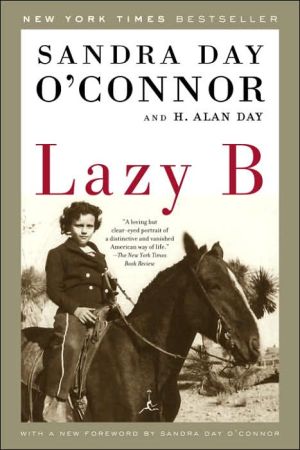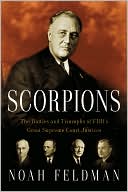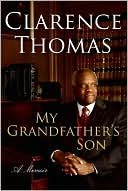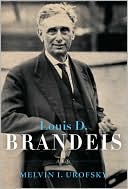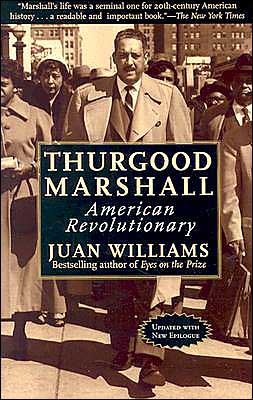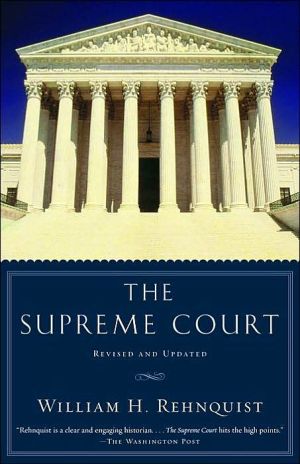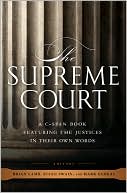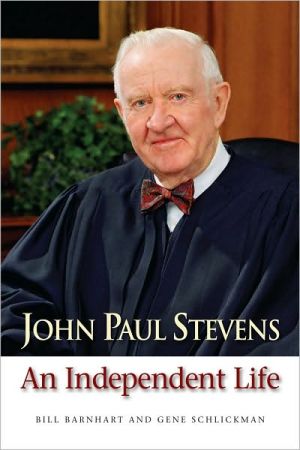Lazy B: Growing up on a Cattle Ranch in the American Southwest
"What was it in Sandra Day O'Connor's background and early life that helped make her the woman she is today - the first female justice of the U.S. Supreme Court, and one of the most powerful women in America? In this beautiful, illuminating, and unusual book, Sandra Day O'Connor, with her brother, Alan, tells the story of the Day family and of growing up on the harsh yet beautiful land of the Lazy B Ranch in Arizona. Laced throughout these stories about three generations of the Day family,...
Search in google:
What was it in Sandra Day O'Connor's background and early life that helped make her the woman she is today-the first female justice of the U.S. Washington Post Book World - Jonathan Yardley Lazy B It is a story about the real American West. Not the West of John Wayne and John Ford, but of hard-working people who took what nature gave them—too much land, too little water—and made it into something productive, valuable and, in the deepest sense of the word, enriching.
Lazy B\ \ By Sandra Day O'Connor and H. Alan Day \ Random House\ Sandra Day O'Connor and H. Alan Day\ All right reserved. \ ISBN: 0679643443 \ \ \ Chapter One\ Chapter 1\ Early Memories\ \ When Time, who steals our years away, Shall steal our pleasure, too, The Memory of the past will stay, And half our joys renew.\ -Thomas Moore, "Song"\ \ The earliest memory is of sounds. In a place of all-encompassing silence, any sound is something to be noted and remembered. When the wind is not blowing, it is so quiet you can hear a beetle scurrying across the ground or a fly landing on a bush. Occasionally an airplane flies overhead-a high-tech intrusion penetrating the agrarian peace.\ \ When the wind blows, as it often does, there are no trees to rustle and moan. But the wind whistles through any loose siding on the barn and causes any loose gate to bang into the fence post. It starts the windmills moving, turning, creaking.\ \ At night the sounds are magnified. Coyotes wail on the hillside, calling to each other or to the moon-a sound that sends chills up the spine. We snuggle deeper in our beds. What prey have the coyotes spotted? Why are they howling? What are they doing? Just before dawn the doves begin to call, with a soft cooing sound, starting the day with their endless search for food. The cattle nearby walk along their trail near the house, their hooves crunching on the gravel. An occasional moo to a calf or to another cow can be heard, or the urgent bawl of a calf that has lost contact with its mother, or the low insistent grunt, almost a growl, of a bull as it walks steadily along to the watering trough or back out to the pasture. The two huge windmills turn in the wind, creaking as they revolve to face the breeze, and producing the clank of the sucker rods as they rise and fall with each turn of the huge fan of the mill.\ \ The Lazy B Ranch straddles the border of Arizona and New Mexico along the Gila River. It is high desert country-dry, windswept, clear, often cloudless. Along the Gila the canyons are choked with cottonwoods and willows. The cliffs rise up sharply and are smooth beige sandstone. The water flowing down the riverbed from the Gila Wilderness to the northeast is usually only a trickle. But sometimes, after summer rains or a winter thaw in the mountains, the river becomes an angry, rushing, mud-colored flood, carrying trees, brush, rocks, and everything else in its path. Scraped into the sandstone bluffs are petroglyphs of the Anasazi of centuries past. Their lives and hardships left these visible traces for us to find, and we marvel at their ability to survive as long as they did in this harsh environment. High up on one of the canyon walls is a small opening to a cave. A few ancient steps are cut out of the bluff leading to it. To reach it now requires climbing apparatus-ropes and pitons. The cave's inner walls have been smoothed with mud plaster, and here and there is a handprint, hardened when the mud dried, centuries ago.\ \ Every living thing in the desert has some kind of protective mechanism or characteristic to survive-thorns, teeth, horns, poison, or perhaps just being too tough to kill and eat. A human living there quickly learns that anything in the desert can hurt you if you are not careful and respectful. Whatever it is can scratch you, bite you, or puncture you. When riding horseback, you have to watch where you are going. The branch of a hardy bush can knock you off; a hole in the ground covered with grass can cause your horse to stumble or fall. When you take a spill, it might be onto a rock or a cactus. When you get off your horse, it pays to look first to avoid stepping in an ant den, on a scorpion, or in the path of a snake. Over the years, Alan, Ann, and I each had our share of falls from a horse, insect bites, injuries, and other dangerous events, which we learned just came with the territory.\ \ South of the Gila and to the east, the land is flat. For some ten miles it is covered with short burro grass and hummocks of tabosa grass. There are soapweeds-tall, hairy-looking yuccas, some with two or three trunks. In May they send up tall stalks with clusters of off-white blossoms that last about a month. These dramatic sentinels in the flat landscape are weirdly beautiful. The stalks, when dry, make good cattle prods, or fine lances for children's war games. The dry pods from the blossoms are good additions in dried-flower arrangements.\ \ The mesa land is part of a large dry lake bed from an earlier time. It is hard to imagine this land covered with water. Places along the edge of it show signs of Indian camps. As children, we found many buff-colored pottery shards, an occasional metate, or grindstone, sometimes a projectile point or pieces of obsidian that had been flaked off in the process of making the projectiles. I would spend the hours waiting for DA to finish some work in that area looking around for some of these bits of Indian life and times. I would take them home to show MO, who greatly enjoyed finding such treasures. We would talk about the lives these early inhabitants led.\ \ Water was scarce and hard to find. Every drop counted. We built catchment basins and dirt tanks to catch and store it. We pumped it from underground. We measured it and used it sparingly. Life depended on it.\ \ There were thirty-five wells and windmills on the Lazy B, and it was a big job to keep them pumping. The windmills and pumps had to be oiled and serviced regularly. During periods of drought and dry weather-periods that seemed to predominate-the ranch crew spent most of their time keeping the wells working and hauling supplemental feed to the cattle. When a well went bad or a pump broke down, it was a serious matter. There might be only a day's supply of water in reserve in that area. The cattle could not survive more than a day of dehydration. There were times when we had to work through the night to try to get the well or pump repaired, to supply the livestock with water.\ \ I recall some grim, difficult times when DA and the cowboys would have to stop all other work to repair a well that had ceased producing water for the cattle. Work would begin at daylight and continue into the night. Sometimes the sucker rods had to be pulled out of the well and removed, one at a time, until the problem was located and solved. It could be a broken sucker rod deep in the well. It could be a corroded casing pipe that was allowing water to escape. It could be any number of things that took strength, time, skill, and energy to repair. There was little I could do to help. The work required more strength than I had. I could serve like an operating-room nurse-I would get a wrench, a hammer, or another tool that was needed and put it into my father's outstretched hand. More often, I read a book I had brought along or I watched the work and engaged in desultory conversation with the men.\ \ If we failed to complete the repairs before the water tank was empty, we had to gather all the cattle and move them to another location where there was enough water and grass for them to survive.\ \ The east part of the Lazy B is on the Lordsburg Flat-a large, flat, desolate area that is not the best grazing land on the ranch. The underground water is about three hundred feet deep and in places does not taste very good, but the older wells in that area all have splendid wooden windmill towers over them. In the 1920s a master craftsman constructed these towers on the site, with beautiful, long, straight timbers all cut by hand and mitered to fit, and they have weathered over the years to a soft gray color.\ \ Some of the names of these watering places are colorful and descriptive. In the east part of the ranch is Z-Bar-L. It was named for the brand MO put on her cattle. The brand had no significance; it is just a brand DA had registered at an earlier time. A few miles away from there is Three Mills, named for the three windmills around the big water pond that served the cattle. When the first well was drilled, it was so weak and produced so little water that two more wells were drilled to supply enough water for the cattle. Wimp Well was named after the scrubby old fellow who drilled it. High Lonesome is the most descriptive name on the ranch. It stands alone as a sentinel over a a large, bare prairie that is roughly on the Continental Divide. When you are there, you can feel that High Lonesome is the proper name. Willow Springs is a shallow well located in a beautiful, narrow, rocky canyon. This is the prettiest location on the ranch.\ \ The ranch headquarters is named Round Mountain, for the perfectly round volcanic cone that rises six hundred feet above the prairie about a mile south of headquarters. Round Mountain is visible from almost anyplace on the ranch and appears on many air-travel maps. Cottonwood Spring is a flowing spring surrounded by large cottonwood trees located in the northeast part of the ranch, near the Gila River. We particularly enjoyed going to Cottonwood Spring; to see water seeping out of the ground was always a miraculous sight in that dry land. The cottonwood trees provided shade, and the canyon, with its steep, colorful walls, was cooler than the surrounding mesas. I could never resist digging in the sandy canyon floor until a pool of water would fill the hole. I also always scoured the canyon walls to try to find petroglyphs etched in the stone. The early Indians who made them left symbols of animal and bird life that have lasted thousands of years.\ \ At eight hundred feet, Lost Lake is the deepest well on the ranch, located adjacent to a dry lake formed by drainage coming out of the mountains that surround it on all four sides. The dry lake bed would sometimes fill with floodwater in the monsoon season. The water flowing in would be brown, muddy, and full of leaves, sticks, debris, and foam from the flash flood. As the water receded over the succeeding weeks, it would leave wide areas of a coating of slippery mud. The cattle would walk through the mud to reach the remaining water, and their legs and even their bellies would have a coating of dried mud on them for months.\ \ Sands Ranch, also a part of the Lazy B, is eight miles south of Lost Lake and was once the homestead of John Sands. He and his son Tom ran goats on this little ranch, but their main income was from the bootleg whiskey they made there. During Prohibition John and Tom took a wagonload of whiskey to Bowie to sell. They made the mistake of selling a gallon to a federal agent who was there to control bootlegging. When the agent attempted to arrest them, John pulled out his pistol and tried to shoot the gallon out of the agent's hand. John was killed in the shoot-out and Tom was shot in the arm. Tom's arm shriveled, and he could never use it again. His heart was no longer at the ranch, so he sold it to the Lazy B. The ranch hands dug a forty-foot-deep well on his land, and that area has always been known as Sands Ranch.\ \ Robbs' Well is up the canyon about five miles east of Sands Ranch and was homesteaded by Fred Robbs. He was unable to make a living on this tough piece of land, but the well he drilled and the old wood shack next to it have always remained as Robbs' Well.\ \ Antelope Well was drilled when Ann was about eight years old. When DA decided to drill a well in that area, he took Ann with him the day he went out to choose a site; the well got its name from a little herd of antelope they saw on the way. DA had brought a green willow limb with them, and he got Ann to "witch" the well with the willow limb. Some people are said to be able to locate underground water by holding a forked willow branch or a peach-tree branch over the area. When the branch pulls down, it indicates that water is below the surface. There was some question about whether they could hit water or not, since several wells had already been drilled in the area-all dry. At the place Ann selected, they ended up drilling through hard rock. During the drilling, the driller came to DA twice to ask for more money per foot for boring through such hard rock. With so much already invested, DA reluctantly agreed. At five hundred feet, they hit a good stream of water. Developing reliable sources of water and keeping all the wells, windmills, and pumps operative was a major part of the work at the Lazy B.\ \ It is possible to survive and even make a living in that formidable terrain. The Day family did it for years; but it was never easy. It takes planning, patience, skill, and endurance. DA said he had to plan for the lean years and the low cattle prices, because there were so few years when there was plenty of rain and a good market for the cattle as well.\ \ \ \ Excerpted from Lazy B by Sandra Day O'Connor and H. Alan Day Excerpted by permission.\ All rights reserved. No part of this excerpt may be reproduced or reprinted without permission in writing from the publisher.\ Excerpts are provided by Dial-A-Book Inc. solely for the personal use of visitors to this web site. \ \
\ From Barnes & NobleThe Barnes & Noble Review\ On a cattle ranch in the southeast corner of Arizona, without electricity or indoor plumbing, a little girl grew up and went on to become the most powerful woman in America. Supreme Court justice Sandra Day O'Connor, the first female on the Court and the swing vote in many major cases, describes her childhood in this delightful memoir. \ Lazy B reflects Sandra's perspective as the oldest of three siblings, but it also includes the recollections of her brother Alan -- such as the summer when, at age 13, he broke eight horses without advice or help. These were happy children in a close and loving family, but they do not glamorize what it was like to live on a ranch, even a large and generally prosperous one. Life was strenuous, the margin of success was very narrow, and drought, hardship, and death were no strangers.\ In brief chapters we witness the family scene, which included the cowboys who worked on the ranch for decades and the vividly remembered horses and other animals, including Bob the bobcat and Sylvester the pet hawk. The year's events, culminating in the roundup, branding, and sale of calves, come to life, as do simple pleasures like swimming in the water tank or a trip to the nearest town. Until young Sandra took part in the roundup, it had been an all-male event. She gained acceptance from the cowboys by doing her job well, a useful prelude to her future role as a gender groundbreaker.\ Following some historical background, most of Lazy B is set in the 1930s and '40s. Gradually, the ranch and its equipment were modernized, and Alan took over the operation as his father aged. The last chapters bring the story forward, with a very funny vignette about Sandra's future husband's first visit to the ranch, and their wedding in the barn; but there is little mention of her later life.\ The book calls to mind another fine memoir, The Road from Coorain, Jill Ker Conway's sadder and bleaker account of growing up on a sheep farm in Australia. Both young women rose to prominence in America, but for Conway there is a sense of escape, while O'Connor remains deeply nostalgic for the Lazy B ranch, which Alan had to sell when none of the succeeding generation wanted to carry on the hard life of a rancher.\ The author's tone is simple and matter-of-fact, except for some quite lyrical passages about the land and the rain. Lazy B, well illustrated with family photographs, should appeal to a wide range of readers. (Stephanie Martin)\ Stephanie Martin lives in Newton Centre, Massachusetts.\ \ \ \ \ \ Jonathan YardleyLazy B It is a story about the real American West. Not the West of John Wayne and John Ford, but of hard-working people who took what nature gave them—too much land, too little water—and made it into something productive, valuable and, in the deepest sense of the word, enriching. \ — Washington Post Book World\ \ \ Linda GreenhouseIn Lazy B., Sandra Day O'Connor and her brother recall their childhoods on a ranch in the Southwest in this engaging memoir. \ — New York Times\ \ \ \ \ From The CriticsBy anyone's standards, Sandra Day O'Connor has lived an extraordinary life. In the twenty years since she became the first female justice on the Supreme Court, O'Connor has become a dominant figure in American politics. The pivotal vote on a factionalized court, she is the decisive voice in some of the nation's central controversies and a leading force in the court's recent efforts to restrain the power of government. \ \ Even before she was appointed to the Supreme Court by Ronald Reagan in 1981, though, her success was remarkable. When she graduated from Stanford Law School in 1952, O'Connor faced a legal profession that was virtually closed to women. Refusing to be discouraged, she dedicated herself to a career in public service, distinguishing herself with a series of civil and political positions—from the lowly job of deputy county attorney of San Mateo, California, where she began her career, to majority leader of the Arizona State Senate. Now considered by some pundits to be a shoo-in for the job of chief justice when William Rehnquist retires, O'Connor may well be, as the legal scholar Jeffrey Rosen writes, "the most powerful woman in America." \ \ In this memoir, written with her brother, H. Alan Day, O'Connor tells of the early experiences that formed the bedrock for those achievements. Growing up on her parents' cattle ranch on the border of Arizona and New Mexico, she learned the value of character and responsibility. The land on the Lazy B ranch was rugged and the life was hardscrabble. "The value system we learned was simple and unsophisticated and the product of necessity," the authors write. "What counted was competence." For those who could live up toits demands, the ranching life nourished "qualities of honesty, dependability ... and good humor" that served them well throughout their lives. \ \ Celebrating those virtues, O'Connor and her brother have written a version of a classic American narrative. Lazy B is a frontier story, a tale of resourceful people who wrest a living from a difficult land and who cherish their independence from the sissified restraints of the more settled East. For seven decades, the Day ranch was a big, profitable concern—at 60,000 acres, it was "the largest and most successful ranch in the region." But in the high desert of the Southwest, ranching did not come easy. Vast and austerely beautiful though it was, the arid landscape did not lend itself naturally to grazing, and a rancher needed to work hard and long to make a go of it. Growing up, O'Connor and her brother watched as their parents turned a failing business into a thriving enterprise, and their narrative glows with admiration for the achievement. Like many tales of the West, Lazy B speaks earnestly of the beauties of nature, but its story is more concerned with the rugged people who could make the land pay. \ \ O'Connor plainly reveres those resourceful pioneers, and the book offers a series of lovingly etched portraits—most significantly of the writers' father, Harry Day, a stern yet supportive patriarch who dominates the book, but also of a gallery of memorable cowhands. (The writers' mother plays a less prominent role.) Yet, colorful as those figures are, Lazy B never prettifies them. As a justice, O'Connor is renowned for her pragmatic and limited opinions. Unlike some colleagues, she declines to speak of fundamental principles or grand philosophies, an attitude she may have learned on the ranch, where "verbal skills were less important than the ability to know and understand how things work." Her memoir shares something of the same deliberate quality. The writers' account of their childhood is scrupulously deadpan and laconic. One suspects that they'd rather risk boring the reader than commit the sin of being flashy. \ \ The one place Lazy B approaches lyricism is, interestingly, also the most political section of the book. It is a convention of the frontier story to speak elegiacally of a fading way of life, and Lazy B concludes by lamenting that "the era of ranching as we knew it ... is surely gone forever." Unsurprisingly, the book lays the responsibility for that decline at the feet of aggressive government agencies and "bureaucratic overkill." The more interesting feature of Lazy B, however, is the book's honesty in revealing that the roots of the authors' distrust of government may lie less in a history of independence from the state than in a long-term dependence on it. Harry Day was surely a capable and industrious man, but the authors also acknowledge that from its very beginnings the Day ranch benefited from government largesse. Without land purchased by the federal government, the ranch would never have existed. Without meddlesome bureaucrats who propped up cattle prices, fostered irrigation and electrification and protected land at risk of overgrazing, it might not have survived, never mind prospered. For Harry Day, ironically, that fact meant that government was worthy not of gratitude but suspicion. Along with the rest of his legacy, his children carry that attitude forward. \ —Sean McCann \ \ \ \ \ \ Publishers WeeklyThis memoir-cum-natural history evinces a clear picture of the American Southwest during the early to mid 20th century. Though O'Connor's name initially conjures images of austere black robes and the halls of justice, a very different person emerges from the childhood recalled here. A collaboration between O'Connor and her brother, the book recounts the lives of their parents "MO" and "DA" (pronounced "M.O." and "D.A.") and the colorful characters who helped run the Lazy B ranch. Growing up on the Gila River flowing from New Mexico to Arizona during the 1930s and '40s, the children quickly learned about the desert's abundant and dangerous creatures and plants. And no experience of Western ranch life is complete without the constant struggle for water leading to disputes over grazing rights. Though life was often harsh, MO kept her children educated and imbued with a sense of dignity. The authors' keen sense of loyalty to their childhood home endures: "Life at the ranch involved all of these components association with our old-time, long-suffering, good-natured cowboys; living in isolation with just one another and with few luxuries; ... seeing the plant, animal, insect, and bird life of the Southwest close at hand; and enjoying the love and companionship of MO and DA." O'Connor attended Stanford University, realizing the dreams of her grandfather and father; there, she took a class from a law school professor and started down the path leading to the U.S. Supreme Court. Day ran the Lazy B until its sale in 1986. The authors' delight in Lazy B enhances this quiet account of a bygone era. Copyright 2001 Cahners Business Information.\ \ \ \ \ Publishers WeeklyWindswept plains, herds of cattle, ornery horses and hard-bitten cowboys fill the childhood memories of Supreme Court Justice Sandra Day O'Connor, who grew up on the Lazy B, a Texas cattle ranch. In this memoir, she writes of the ranch's history, from its founding in the 1880s by her grandfather to the sad moment when the family sold it in 1986. O'Connor gives a detailed account of ranch life: the hard work, the urgent dependence on rain, the colorful characters who worked on the ranch, the bureaucracy of government officials and land-use permits, and her own happy childhood memories of hours in the saddle. The mood is warm and nostalgic: she does not mention any conflict with her parents, failed romances, serious illnesses or other negative experiences, other than a brief comment that she wasn't happy in one school and switched to another. O'Connor frequently stresses that to succeed in ranching, one had to be tough, resilient and hardworking, but she contrasts that toughness with the ranchers' warm hearts. Talking of her babyhood surrounded by cowboys, she says, "My babysitters were tobacco-chewing, unshaven, unbathed, Levi-clad and tough as nails, but they would talk baby talk and try for hours to keep baby Sandra happy." O'Connor is not a professional narrator and it shows: she is clearly "reading aloud" without spontaneity, and her reading is mostly one-note, without the varied inflections and shades of emotion that a professional narrator would bring. Still, her voice is pleasant, with a slight Texas twang, and she conveys warmth and affection for her childhood home. Simultaneous release with the Random House hardcover (Forecasts, Dec. 10, 2001). (Jan.) Copyright 2001 Cahners Business Information.\ \ \ \ \ KLIATTO'Connor and her brother Alan, nine years her junior, teamed up to write an account of growing up on "the largest and most successful ranch in the region," a spread one-fifth the size of the state of Rhode Island, located on the Arizona/New Mexico border. Brief essays introduced by b/w photos and incisive quotations give thumbnail bios of their parents and individual cowboys who worked on the ranch. Other chapters tell of drought and rain, animals (cattle, horses, pets, wildlife), their adobe home, family life, going to school, the local bar, and always the hard work and careful management of resources that supported them all. O'Connor's parents loved each other deeply their whole lives and set education for their three children (their sister Ann is near Alan's age) as a high priority. There is no discussion of politics and little about the professional path that led to Sandra's appointment by Reagan to the Supreme Court. She went to a nearby high school, attended Stanford University Law School, and married a lawyer from San Francisco. She became the mother of three sons and always, until the death of her parents and the sale of the ranch, found solace in its open spaces and the routines of life there. The only really discordant note in the book concerns the increasing involvement of the government and environmentalists with the management of the land, an interference she felt was often ill-informed and led to the breaking up of the ranch and finally its sale. One often feels that the Days smoothed off the roughest edges of their experience, but their story is told with appreciation for all, humans and animals, that had a part in their lives. It is an inspiring story of the benefits thatcan be gained by a life lived with meaningful work and consistently applied positive life principles. The use of childhood nicknames, such as the initials MO and DA, when referring to their parents, grates throughout, but that is not a reason to reject the book. KLIATT Codes: SA;Recommended for senior high school students, advanced students, and adults. 2002, Random House, 318p. illus., Boardman\ \ \ \ \ Library JournalSupreme Court justices tend to be reticent about their background, and they often disclaim its influence on their thinking. Thus, a memoir purporting to disclose "how Sandra Day O'Connor became the woman she is today" promises to be exciting. This memoir is, however, one of the least revealing examples of the genre. When O'Connor was growing up, her family owned the Lazy B ranch in Arizona. But after the age of six (except for one year in high school), O'Connor lived with her grandmother in El Paso during the school year, an experience about which she says little. Her descriptions of life on the ranch thus rely heavily on summers and vacations and accounts from her brother, Alan, who stayed and ultimately came to run the ranch until it was sold in 1986. We learn about breaking horses and cattle round-ups and the foibles and personalities of various ranch hands. But the book contains only brief descriptions of O'Connor's parents and almost no discussion of ideas. The episodic organization is choppy and the writing often stilted. Still, this book may have an audience. For large public libraries. [Previewed in Prepub Alert, LJ 10/1/01.] Cynthia Harrison, George Washington Univ., Washington, DC Copyright 2001 Cahners Business Information.\ \ \ \ \ School Library JournalAdult/High School-Three generations of the Day family worked a 300-acre ranch straddling the Arizona-New Mexico border, from the 1880s to 1986. During that time, family members experienced all the aspects of Western life that most of us today can only encounter through films or books. Reading Lazy B, teens will find themselves in the middle of cattle roundups, stampedes, floods, and drought. Through photographs, letters, personal experiences, and anecdotes, the authors present a slice of day-to-day life on a working ranch in the 20th century. Readers meet the cowboys, learn what it takes to break a wild horse, find out how a roundup works, and see the government's growing role in ranching and farming. This is not the book for those wanting to learn the secrets of O'Connor's successful rise to a seat on the Supreme Court. But for those wanting a glimpse of a rapidly disappearing way of life, this title presents an engaging and compelling account.-Pamela B. Rearden, Centreville Regional Library, Fairfax County, VA Copyright 2002 Cahners Business Information.\ \ \ \ \ Kirkus ReviewsThe Supreme Court justice, writing with her brother, turns in an affectionate portrait of life on a desert ranch in the years before WWII.\ \
